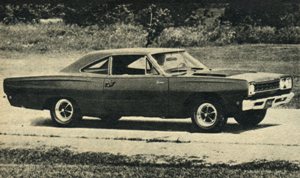The 327 cid L79 was rated at 350 horsepower at 5,800 rpm and 360 Ib-fl of torque at 3,600 rpm. The cast iron block used a forged steel crank and rods, aluminum forged pistons with 11.0:1 compression and hydraulic lifters. The L79 boasted "double hump" big valve heads (2.02inch intake and 1.6-inch exhaust) and a high-lift camshaft with .447 lift. A Holley 600 cfm carburetor mounted on a dualplane, high-rise aluminum intake manifold was part of the engine package, along with a chrome twin-snorkel air cleaner that matched the shiny valve covers and oil filler cap. Standard gearbox was the threespeed manual transmission, with a wide ratio M20 or close ratio M21 four-speed manual transmission optional. A variety of rear axle ratios were offered, with 3.31:1 gearing standard in a 12-bolt differential.
Bolted into the 3,100-pound Nova body, the L79 provided a great power-to-weight bargain that, in stock condition, resulted in 0-60 times of 7.2 seconds and quarter-mile performance at 15.1 seconds at 93 mph as tested by Car Life magazine in their May 1966 issue. With some minor tuning, headers and slicks, the L79 Nova could easily go into the high 13s.
Musclecar buyers found the L79 SS Nova to be an attractive alternative to larger, more costly performance cars. Chevrolet's records indicate 20,986 SS Novas (4,675 I-6 and 16,311 V8) were sold in 1966. Of that total, 5,481 were equipped with RPO L79, and 3,547 of them were installed in two-door SS models. The L79 wasn't limited to just the SS option; approximately 200 L79-equipped 100 series Nova two-door sedans were also produced.
Chevrolet L84 fuel injected 327
For years, the Corvette was the proving ground for leading-edge small-block V-8 development. It culminated with the L84 fuel-injected 327, available from 1962-1965. Rated at 360hp in 1962 and '63, and 375hp thereafter, the L84 was not for the casual buyer, thanks to an 11.25:1 compression ratio and solid lifter cam. The Rochester fuel injection system was also costly and cranky, but when in proper tune, turned the Corvette Sting Ray into a world-class sports car.
1968 Oldsmobile W-31 350
The 1968 W-31 "Ram Rod" Olds was essentially a factory-built race car, available to anyone who knew how to navigate a Cutlass order form. Rated at 325hp but producing closer to 360hp, the hot 350 was assembled using hand-selected parts. The cylinder heads were sent to an outside company for installation of larger valves and special valve springs, and the engines were then dyno tested to ensure promised horsepower was delivered. Once installed, the W-31 engine was hooked to a cold air induction set-up to maximize engine breathing. The W-31 option continued for a few more years, still employing the heavy-duty parts, although later editions did not receive the special hand-built attention of the 1968 versions. The '68 W-31 proved to be the hottest small-displacement Olds engine of all.
1967-69 Chevrolet 302
Although Chevrolet wasn't officially involved in racing in the late 1960s, there were still key employees inside the company who didn't want to see their cars embarrassed at the race track, and they found ways to make sure it didn't happen. The original Z/28 Camaro is the best example of this. To compete effectively against the Mustangs, Cougars and Barracudas in the SCCA's Trans Am racing series, Chevrolet needed a compact coupe that handled well and cranked out as much power as possible from the SCCA's displacement limit of 5.0 liters.
Chevy created a 302ci small-block exclusive to the Z/28 by combining a 327 block with a 283 crankshaft. The 302 was stuffed with parts aimed at racers – forged steel crankshaft and connecting rods, TRW pistons, solid-lifter cam with 0.485-inch lift, large 2.02 inch intake valves with 1.60-inch exhaust valves, a windage tray, and an 800cfm Holley four-barrel on an aluminum high-rise intake manifold. The compression ratio was a stout 11.0:1.
For a company not officially involved in racing, it all worked out remarkable well on track. Z/28s piloted by Mark Donohue won Trans Am championships in 1968 and 1969. On the street, the 302 helped establish the Z/28 as one of the most enduring nameplates in musclecar history.
1970 Chevrolet LT-1 350
Granted, the performance tricks employed to create the LT-1 350 were well-established by the time 1970 rolled around, but combined with 350 cubic inches of displacement, and dropped in the new Z/28 Camaro and the still-fresh 1970 Corvette, these tried-and-true methods resulted in one of the best small-block powerplants of all time. The LT-1 came with four-bolt main caps, a forged crankshaft and connecting rods, aluminum TRW pistons, an 11.0:1 compression ratio, solid-lifter cam, 780cfm Holley 4-barrel on a highrise aluminum intake manifold, and 2.5-inch exhaust pipes.
As with most serious performance engines, you could forget about air conditioning - it wasn't an option that first year. In 1970, the LT-1 was rated at 370hp in the Corvette, and 360hp in the Z/28 Camaro. The LT-1 continued for a couple more seasons, hobbled somewhat by lower compression, but it was still the most potent small-block Chevy of its time.
1971 Ford Boss 351
The Boss 351 was Ford's last great powerplant of the original musclecar era. Ford maximized the big-port 351 Cleveland's abilities with an 11.0:1 compression ratio, forged pop-up pistons, solid lifters and a 750cfm Autolite four-barrel carburetor. The block was a sturdy four-bolt main unit, and the engine was teamed with the necessary heavy-duty gear, such as a Traction-Lok differential, heavy-duty radiator, ram air induction and competition suspension. Magazine road tests of the time routinely recorded high 13-second ETs. Thanks to encroaching emission control regulations the Boss 351 was a one-year wonder, but what a year.

















